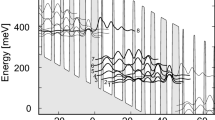Abstract
Experimental measurements of small-signal gain in an optically-pumped NH3 amplifier are carried out at pressures ranging from 40 Torr to 760 Torr, and the results are used to validate a rate-equation model describing the amplifier dynamics. The gain measurements show that dilute mixtures of <0.5% NH3 in N2 are reqired to minimize the problems of gas heating due to pump absorption. The model is used to extrapolate the results to gas pressures of several atmospheres, and to demonstrate the potential for highpressure operation of optically-pumped NH3 lasers. For a pump intensity of 100 MW/cm2, calculations indicate that operation of an NH3−N2 laser is feasible up to a pressure of 10 atm, which would provide a maximum continuous tuning range of 4 cm−1. High-resolution spectroscopy reveals that gain on a few NH3 transitions is eliminated at high pressures due to the presence of overlapping absorptions in other NH3 bands.
Similar content being viewed by others
References
B.I. Vasil'ev, A.Z. Grasyuk, A.P. Dyad'kin, A.N. Sukhanov, A.B. Yastrebkov: Sov. J. QE-10, 64–68 (1980)
H. Tashiro, K. Suzuki, K. Toyoda, S. Namba: Appl. Phys.21, 237–240 (1980)
M. Akhrarov, B.I. Vasil'ev, A.Z. Grasyuk, A.B. Yastrebkov: Sov. J. QE-12, 1326–1329 (1982)
M. Akhrarov, B.I. Vasil'ev, A.Z. Grasyuk, A.B. Yastrebkov, Sov. J. QE-13, 357–361 (1983)
H. Tashiro, T. Koizumi, K. Toyoda, S. Namba: Opt. Lett.9, 279–281 (1984)
Š. Urban, D. Papoušek, J. Kauppinen, K. Yamada, G. Winnewisser: J. Mol.Spectrosc.101, 1–15 (1983)
M. Akhrarov, B.I. Vasil'ev, A.Z. Grasyuk, A.B. Yastrebkov: Sov. J. QE-12, 405–408 (1982)
E.D. Shaw, C.K.N. Patel: Opt. Commun.27, 419–422 (1978). This study and [9] report results on directly-pumped transitions in pressures of 5–30 Torr of pure NH3. Thus, the gain bandwidth is due to ac Stark shifts and the bandwidth of the pump source through the Raman process, and not due to pressure broadening. This result does not detract from the general applicability of synchronous pumping to the conditions examined in this paper
B.K. Deka, P.E. Dyer, I.K. Perera: Opt. Commun.37, 127–132 (1981)
H.D. Morrison, B.K. Garside, J. Reid: IEEE J. QE-20, 1051–1060 (1984)
H.D. Morrison, B.K. Garside, J. Reid: J. Opt. Soc. Am. B (in press)
C. Rolland, J. Reid, B.K. Garside: IEEE J. QE-18, 182–186 (1982)
P. Minguzzi, M. Tonelli, A. Carrozzi, A. Di Lieto: J. Mol. Spectrosc.96, 294–305 (1982)
C. Rolland, J. Reid, B.K. Garside: Appl. Phys. Lett.44, 380–382 (1984)
S.-T. Wu, M. Bass: Appl. Phys. Lett.39, 948–950 (1981)
For the present calculations, the temperature dependence of the NH3 V-T rate was defined by a decaying-exponential fit to the data listed by F.E. Hovis, C.B. Moore: J. Chem.Phys.72, 2397–2402 (1980)
J.P. Sattler, L.S. Miller, T.L. Worchesky: J. Mol. Spectrosc.88, 347–351 (1981)
D.E. Jennings: Appl. Opt.19, 2695–2700 (1980)
D.T. Cassidy, J. Reid: Appl. Opt.21, 2527–2530 (1982)
Š. Urban, V. Špirko, D. Papoušek, R.S. McDowell, N.G. Nereson, S.P. Belov, L.I. Gershstein, A.V. Maslovskij, A.F. Krupnov, J. Curtis, K.N. Rao: J. Mol. Spectrosc.79, 455–495 (1980)
H. Sasada, Y. Hasegawa, T. Amano, T. Shimizu: J. Mol. Spectrosc.96, 106–130 (1982)
G. Baldacchini, S. Marchetti, V. Montelatici, M. Di Lonardo, R.P. Leavitt, J.P. Sattler: J. Mol.Spectrosc.95, 30–34 (1982)
There is an overall decrease in the gain coefficients at the higher pressure due to the increase in the relaxation rates relative to the pumping rate which reduces the population inversion. Less effective pumping is more noticeable on theQ andR transitions, as they are more sensitive to changes in the population inversion




